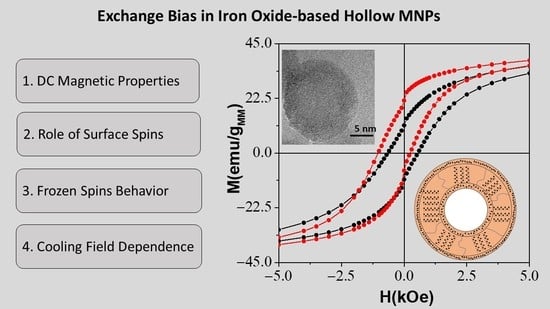Significant Surface Spin Effects and Exchange Bias in Iron Oxide-Based Hollow Magnetic Nanoparticles
Abstract
:1. Introduction
2. Materials and Methods
2.1. Chemicals and Materials
2.2. Synthesis of Core/Void/Shell Nanoparticles (Fe/Iron Oxide)
2.3. Synthesis of Hollow Magnetic Nanoparticles (Iron Oxide)
2.4. Physicochemical and Magnetic Characterization of Core/Void/Shell and Hollow MNPs
3. Results and Discussion
3.1. Structural, Chemical, and Morphological Properties
3.1.1. XRD Characterization
3.1.2. FT-IR Spectroscopy
3.1.3. Transmission Electron Microscopies (TEM)
3.1.4. Room Temperature Mössbauer Spectra
3.2. DC Magnetic Properties
3.3. Exchange Bias Properties
3.4. Role of Surface Spins
3.5. Remanence (MR) and Coercivity (HC) Dependence with Cooling Field (HFC)
3.6. Frozen Spins Behavior
4. Conclusions
Supplementary Materials
Author Contributions
Funding
Institutional Review Board Statement
Informed Consent Statement
Data Availability Statement
Acknowledgments
Conflicts of Interest
References
- Binek, C.; Hochstrat, A.; Chen, X.; Borisov, P.; Kleemann, W.; Doudin, B. Electrically controlled exchange bias for spintronic applications. J. Appl. Phys. 2005, 97, 10. [Google Scholar] [CrossRef] [Green Version]
- Wei, Z.; Sharma, A.; Nunez, A.S.; Haney, P.M.; Duine, R.A.; Bass, J.; MacDonald, A.H.; Tsoi, M. Changing Exchange Bias in Spin Valves with an Electric Current. Phys. Rev. Lett. 2007, 98, 116603. [Google Scholar] [CrossRef] [PubMed] [Green Version]
- De Araujo, C.I.L.; Alves, S.G.; Buda-Prejbeanu, L.D.; Dieny, B. Multilevel Thermally Assisted Magnetoresistive Random-Access Memory Based on Exchange-Biased Vortex Configurations. Phys. Rev. Appl. 2016, 6, 024015. [Google Scholar] [CrossRef]
- Skumryev, V.; Stoyanov, S.; Zhang, Y.; Hadjipanayis, G.; Givord, D.; Nogues, J. Beating the superparamagnetic limit with exchange bias. Nature 2003, 423, 850–853. [Google Scholar] [CrossRef] [PubMed]
- Phan, M.H.; Alonso, J.; Khurshid, H.; Lampen-Kelley, P.; Chandra, S.; Stojak Repa, K.; Nemati, Z.; Das, R.; Iglesias, Ó.; Srikanth, H. Exchange Bias Effects in Iron Oxide-Based Nanoparticle Systems. Nanomaterials 2016, 6, 221. [Google Scholar] [CrossRef]
- Nogues, J.; Lederman, D.; Moran, T.J.; Schuller, I.K. Positive Exchange Bias in FeF2-Fe Bilayers. Phys. Rev. Lett. 1996, 76, 4624–4627. [Google Scholar] [CrossRef] [Green Version]
- Baltz, V.; Sort, J.; Landis, S.; Rodmacq, B.; Dieny, B. Tailoring Size Effects on the Exchange Bias in Ferromagnetic-Antiferromagnetic <100 nmNanostructures. Phys. Rev. Lett. 2005, 94, 117201. [Google Scholar] [CrossRef] [Green Version]
- Vasilakaki, M.; Trohidou, K.N. Numerical study of the exchange-bias effect in nanoparticles with ferromagnetic core/ferrimagnetic disordered shell morphology. Phys. Rev. B 2009, 79, 144402. [Google Scholar] [CrossRef]
- Troitiño, N.F.; Rivas-Murias, B.; Rodríguez-González, B.; Salgueiriño, V. Exchange Bias Effect in CoO@Fe3O4 Core–Shell Octahedron-Shaped Nanoparticles. Chem. Mater. 2014, 26, 5566–5575. [Google Scholar] [CrossRef]
- Meiklejohn, W.H.; Bean, C.P. New Magnetic Anisotropy. Phys. Rev. 1957, 105, 904–913. [Google Scholar] [CrossRef]
- Vázquez-Vázquez, C.; López-Quintela, M.A.; Buján-Núñez, M.D.C.; Rivas, J. Finite size and surface effects on the magnetic properties of cobalt ferrite nanoparticles. J. Nanopart. Res. 2011, 13, 1663–1676. [Google Scholar] [CrossRef]
- Rinaldi-Montes, N.; Gorria, P.; Martínez-Blanco, D.; Fuertes, A.B.; Barquín, L.F.; Puente-Orench, I.; Blanco, J.A. Bridging exchange bias effect in NiO and Ni(core)@NiO(shell) nanoparticles. J. Magn. Magn. Mater. 2016, 400, 236–241. [Google Scholar] [CrossRef]
- Kachkachi, H.; Ezzir, A.; Noguès, M.; Tronc, E. Surface effects in nanoparticles: Application to maghemite -Fe O. Eur. Phys. J. B 2000, 14, 681–689. [Google Scholar] [CrossRef] [Green Version]
- Fiorani, D.; Testa, A.M.; Tronc, E.; Lucari, F.; D’Orazio, F.; Nogués, M. Spin freezing in maghemite nanoparticle systems. J. Magn. Magn. Mater. 2001, 226–230, 1942–1944. [Google Scholar] [CrossRef]
- Brice-Profeta, S.; Arrio, M.-A.; Tronc, E.; Menguy, N.; Letard, I.; Moulin, C.C.D.; Noguès, M.; Chanéac, C.; Jolivet, J.-P.; Sainctavit, P. Magnetic order in nanoparticles: A XMCD study. J. Magn. Magn. Mater. 2005, 288, 354–365. [Google Scholar] [CrossRef]
- Dormann, J.; Cherkaoui, R.; Spinu, L.; Noguès, M.; Lucari, F.; D’Orazio, F.; Fiorani, D.; García-Santiago, A.; Tronc, E.; Jolivet, J. From pure superparamagnetic regime to glass collective state of magnetic moments in γ-Fe2O3 nanoparticle assemblies. J. Magn. Magn. Mater. 1998, 187, L139–L144. [Google Scholar] [CrossRef]
- Goya, G.; Berquo, T.S.; Fonseca, F.C.; Morales, M.D.P. Static and dynamic magnetic properties of spherical magnetite nanoparticles. J. Appl. Phys. 2003, 94, 3520–3528. [Google Scholar] [CrossRef] [Green Version]
- Dutta, P.K.; Pal, S.C.; Seehra, M.S.; Shah, N.; Huffman, G.P. Size dependence of magnetic parameters and surface disorder in magnetite nanoparticles. J. Appl. Phys. 2009, 105, 07B501. [Google Scholar] [CrossRef]
- Zysler, R.; Winkler, E.; Mansilla, M.V.; Fiorani, D. Surface effect in the magnetic order of antiferromagnetic nanoparticles. Phys. B Condens. Matter 2006, 384, 277–281. [Google Scholar] [CrossRef]
- Ghoshani, M.; Sánchez, E.H.; Lee, S.S.; Singh, G.; Yaacoub, N.; Peddis, D.; Mozaffari, M.; Binns, C.; De Toro, J.A.; Normile, P.S. On the detection of surface spin freezing in iron oxide nanoparticles and its long-term evolution under ambient oxidation. Nanotechnology 2021, 32, 065704. [Google Scholar] [CrossRef]
- Shendruk, T.; Desautels, R.; Southern, B.W.; van Lierop, J. The effect of surface spin disorder on the magnetism of γ-Fe2O3 nanoparticle dispersions. Nanotechnology 2007, 18, 455704. [Google Scholar] [CrossRef]
- Martínez, B.; Obradors, X.; Balcells, L.; Rouanet, A.; Monty, C. Low Temperature Surface Spin-Glass Transition in γ-Fe2O3 Nanoparticles. Phys. Rev. Lett. 1998, 80, 181–184. [Google Scholar] [CrossRef]
- Ong, Q.K.; Wei, A.; Lin, X.-M. Exchange bias inFe/Fe3O4 core-shell magnetic nanoparticles mediated by frozen interfacial spins. Phys. Rev. B 2009, 80, 134418. [Google Scholar] [CrossRef]
- Sayed, F.; Labaye, Y.; Hassan, R.S.; Hassan, F.E.H.; Yaacoub, N.; Greneche, J.-M. Size and thickness effect on magnetic structures of maghemite hollow magnetic nanoparticles. J. Nanopart. Res. 2016, 18, 279. [Google Scholar] [CrossRef]
- Khurshid, H.; Phan, M.-H.; Mukherjee, P.; Srikanth, H. Tuning exchange bias in Fe/γ-Fe2O3 core-shell nanoparticles: Impacts of interface and surface spins. Appl. Phys. Lett. 2014, 104, 072407. [Google Scholar] [CrossRef] [Green Version]
- Khurshid, H.; Li, W.; Chandra, S.; Phan, M.-H.; Hadjipanayis, G.C.; Mukherjee, P.; Srikanth, H. Mechanism and controlled growth of shape and size variant core/shell FeO/Fe3O4 nanoparticles. Nanoscale 2013, 5, 7942–7952. [Google Scholar] [CrossRef]
- Hwang, Y.; Angappane, S.; Park, J.; An, K.; Hyeon, T.; Park, J.-G. Exchange bias behavior of monodisperse Fe3O4/γ-Fe2O3 core/shell nanoparticles. Curr. Appl. Phys. 2012, 12, 808–811. [Google Scholar] [CrossRef]
- Panagiotopoulos, I.; Basina, G.; Alexandrakis, V.; Devlin, E.; Hadjipanayis, G.; Colak, L.; Niarchos, D.; Tzitzios, V. Synthesis and Exchange Bias in γ-Fe2O3/CoO and Reverse CoO/γ-Fe2O3 Binary Nanoparticles. J. Phys. Chem. C 2009, 113, 14609–14614. [Google Scholar] [CrossRef]
- Lak, A.; Kraken, M.; Ludwig, F.; Kornowski, A.; Eberbeck, D.; Sievers, S.; Litterst, F.J.; Weller, H.; Schilling, M. Size dependent structural and magnetic properties of FeO–Fe3O4 nanoparticles. Nanoscale 2013, 5, 12286–12295. [Google Scholar] [CrossRef] [Green Version]
- Sun, X.; Huls, N.F.; Sigdel, A.; Sun, S. Tuning Exchange Bias in Core/Shell FeO/Fe3O4 Nanoparticles. Nano Lett. 2012, 12, 246–251. [Google Scholar] [CrossRef]
- Kavich, D.W.; Dickerson, J.H.; Mahajan, S.V.; Hasan, S.A.; Park, J.-H. Exchange bias of singly inverted FeO/Fe3O4 core-shell nanocrystals. Phys. Rev. B 2008, 78, 174414. [Google Scholar] [CrossRef]
- Nemati, Z.; Khurshid, H.; Alonso, J.; Phan, M.H.; Mukherjee, P.; Srikanth, H. From core/shell to hollow Fe/γ-Fe2O3 nanoparticles: Evolution of the magnetic behavior. Nanotechnology 2015, 26, 405705. [Google Scholar] [CrossRef] [PubMed]
- Ong, Q.K.; Lin, X.-M.; Wei, A. Role of Frozen Spins in the Exchange Anisotropy of Core−Shell Fe@Fe3O4 Nanoparticles. J. Phys. Chem. C 2011, 115, 2665–2672. [Google Scholar] [CrossRef] [PubMed] [Green Version]
- Khurshid, H.; Li, W.; Phan, M.H.; Mukherjee, P.; Hadjipanayis, G.C.; Srikanth, H. Surface spin disorder and exchange-bias in hollow maghemite nanoparticles. Appl. Phys. Lett. 2012, 101, 022403. [Google Scholar] [CrossRef] [Green Version]
- Jaffari, G.H.; Ceylan, A.; Bui, H.P.; Beebe, T.P., Jr.; Ozcan, S.; Shah, S.I. Non-equilibrium cation distribution and enhanced spin disorder in hollow CoFe2O4nanoparticles. J. Phys. Condens. Matter 2012, 24, 336004. [Google Scholar] [CrossRef]
- Jaffari, G.H.; Ceylan, A.; Ni, C.; Shah, S.I. Enhancement of surface spin disorder in hollow NiFe2O4 nanoparticles. J. Appl. Phys. 2010, 107, 13910. [Google Scholar] [CrossRef]
- Cabot, A.; Alivisatos, A.P.; Puntes, V.F.; Balcells, L.; Iglesias, Ò.; Labarta, A. Magnetic domains and surface effects in hollow maghemite nanoparticles. Phys. Rev. B 2009, 79, 094419. [Google Scholar] [CrossRef] [Green Version]
- Sayed, F.; Yaacoub, N.; Labaye, Y.; Hassan, R.S.; Singh, G.; Kumar, P.A.; Greneche, J.M.; Mathieu, R.; Hadjipanayis, G.C.; Agostinelli, E.; et al. Surface Effects in Ultrathin Iron Oxide Hollow Nanoparticles: Exploring Magnetic Disorder at the Nanoscale. J. Phys. Chem. C 2018, 122, 7516–7524. [Google Scholar] [CrossRef]
- Iglesias, O.; Labarta, A.; Batlle, X. Exchange Bias Phenomenology and Models of Core/Shell Nanoparticles. J. Nanosci. Nanotechnol. 2008, 8, 2761–2780. [Google Scholar] [CrossRef] [Green Version]
- Mumtaz, A.; Maaz, K.; Janjua, B.; Hasanain, S.; Bertino, M. Exchange bias and vertical shift in CoFe2O4 nanoparticles. J. Magn. Magn. Mater. 2007, 313, 266–272. [Google Scholar] [CrossRef] [Green Version]
- Wang, H.; Zhu, T.; Zhao, K.; Wang, W.N.; Wang, C.S.; Wang, Y.J.; Zhan, W.S. Surface spin glass and exchange bias in Fe3O4 nanoparticles compacted under high pressure. Phys. Rev. B 2004, 70, 092409. [Google Scholar] [CrossRef]
- Del Bianco, L.; Fiorani, D.; Testa, A.M.; Bonetti, E.; Signorini, L. Field-cooling dependence of exchange bias in a granular system of Fe nanoparticles embedded in an Fe oxide matrix. Phys. Rev. B 2004, 70, 052401. [Google Scholar] [CrossRef]
- Peng, S.; Sun, S. Synthesis and Characterization of Monodisperse Hollow Fe3O4 Nanoparticles. Angew. Chem. Int. Ed. 2007, 46, 4155–4158. [Google Scholar] [CrossRef] [PubMed]
- Brand, R.A. Normos Mössbauer Fitting Program. Univ.Duisburg. 2002. Available online: https://www.uni-due.de/~hm236ap/keune/deutsch/Bran/r.a.brand.homepage.htm#Normos (accessed on 21 January 2022).
- Coker, V.S.; Bell, A.M.T.; Pearce, C.I.; Pattrick, R.A.; van der Laan, G.; Lloyd, J. Time-resolved synchrotron powder X-ray diffraction study of magnetite formation by the Fe(III)-reducing bacterium Geobacter sulfurreducens. Am. Mineral. 2008, 93, 540–547. [Google Scholar] [CrossRef]
- Swanson, H.E.; McMurdie, H.F.; Morris, M.C.; Evans, E.H. Standard X-ray Diffraction Powder Patterns; U.S. Department of Commerce, National Bureau of Standards: Gaithersburg, MD, USA, 1967. [CrossRef]
- Maity, D.; Choo, S.G.; Yi, J.; Ding, J.; Xue, J.M. Synthesis of magnetite nanoparticles via a solvent-free thermal decomposition route. J. Magn. Magn. Mater. 2009, 321, 1256–1259. [Google Scholar] [CrossRef]
- Berti, I.O.P.D.; Cagnoli, M.V.; Pecchi, G.; Alessandrini, J.L.; Stewart, S.J.; Bengoa, J.F.; Marchetti, S.G. Alternative low-cost approach to the synthesis of magnetic iron oxide nanoparticles by thermal decomposition of organic precursors. Nanotechnology 2013, 24, 175601. [Google Scholar] [CrossRef]
- Wang, L.; Bao, J.; Wang, L.; Zhang, F.; Li, Y. One-Pot Synthesis and Bioapplication of Amine-Functionalized Magnetite Nanoparticles and Hollow Nanospheres. Chem. Eur. J. 2006, 12, 6341–6347. [Google Scholar] [CrossRef]
- Singh, L.H.; Govindaraj, R.; Amarendra, G.; Sundar, C.S. Local structure and magnetic properties of cubic iron oxide nanoparticles formed in zeolite as deduced using Mössbauer spectroscopy. Appl. Phys. Lett. 2013, 103, 193104. [Google Scholar] [CrossRef]
- Mikhaylova, M.; Kim, D.K.; Bobrysheva, N.; Osmolowsky, M.; Semenov, V.; Tsakalakos, T.; Muhammed, M. Superparamagnetism of Magnetite Nanoparticles: Dependence on Surface Modification. Langmuir 2004, 20, 2472–2477. [Google Scholar] [CrossRef]
- Joos, A.; Rümenapp, C.; Wagner, F.E.; Gleich, B. Characterisation of iron oxide nanoparticles by Mössbauer spectroscopy at ambient temperature. J. Magn. Magn. Mater. 2016, 399, 123–129. [Google Scholar] [CrossRef]
- Khurshid, H.; Lampen-Kelley, P.; Iglesias, O.; Alonso, J.; Phan, M.-H.; Sun, C.-J.; Saboungi, M.-L.; Srikanth, H. Spin-glass-like freezing of inner and outer surface layers in hollow γ-Fe2O3 nanoparticles. Sci. Rep. 2015, 5, 15054. [Google Scholar] [CrossRef] [PubMed]


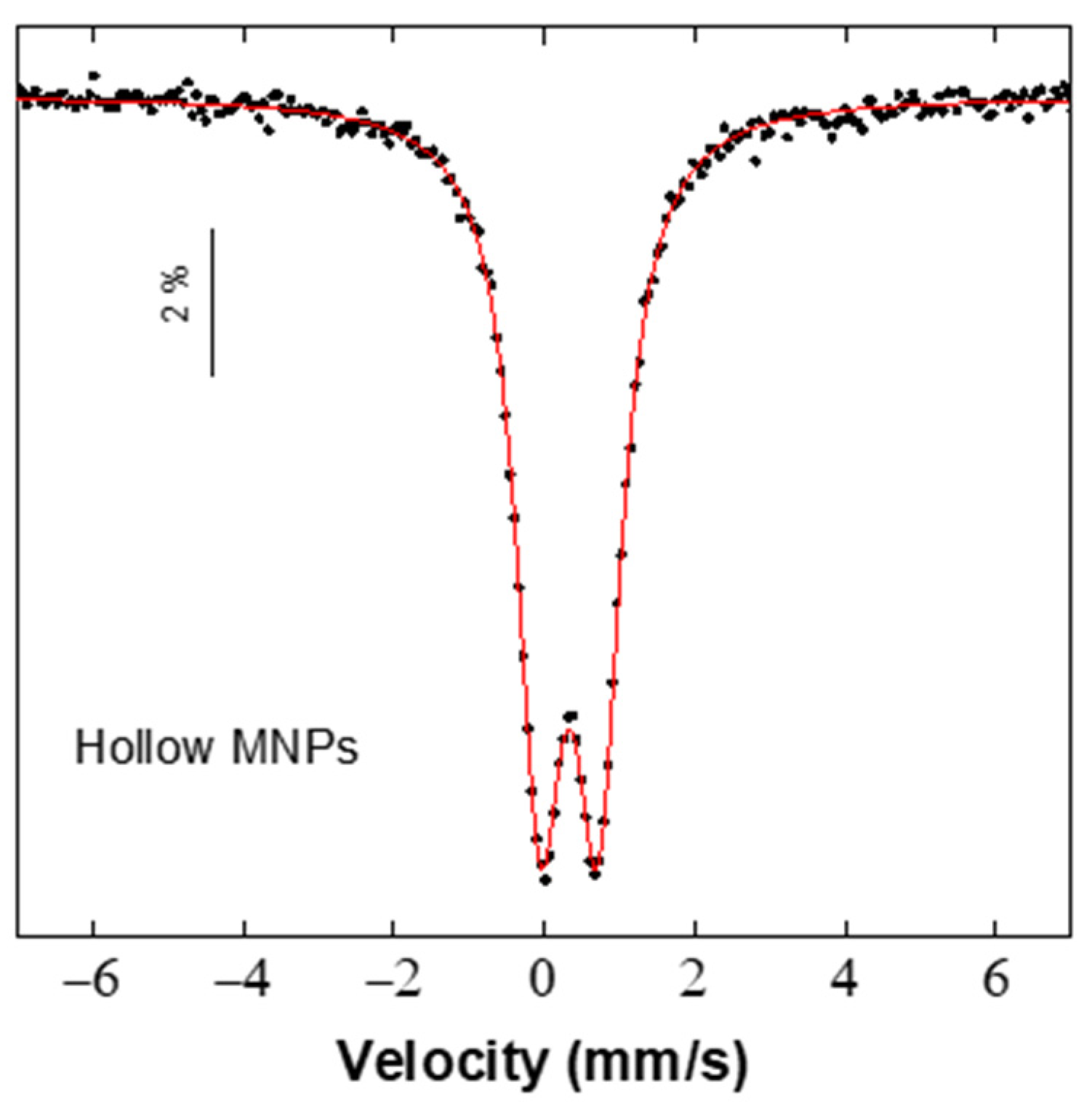
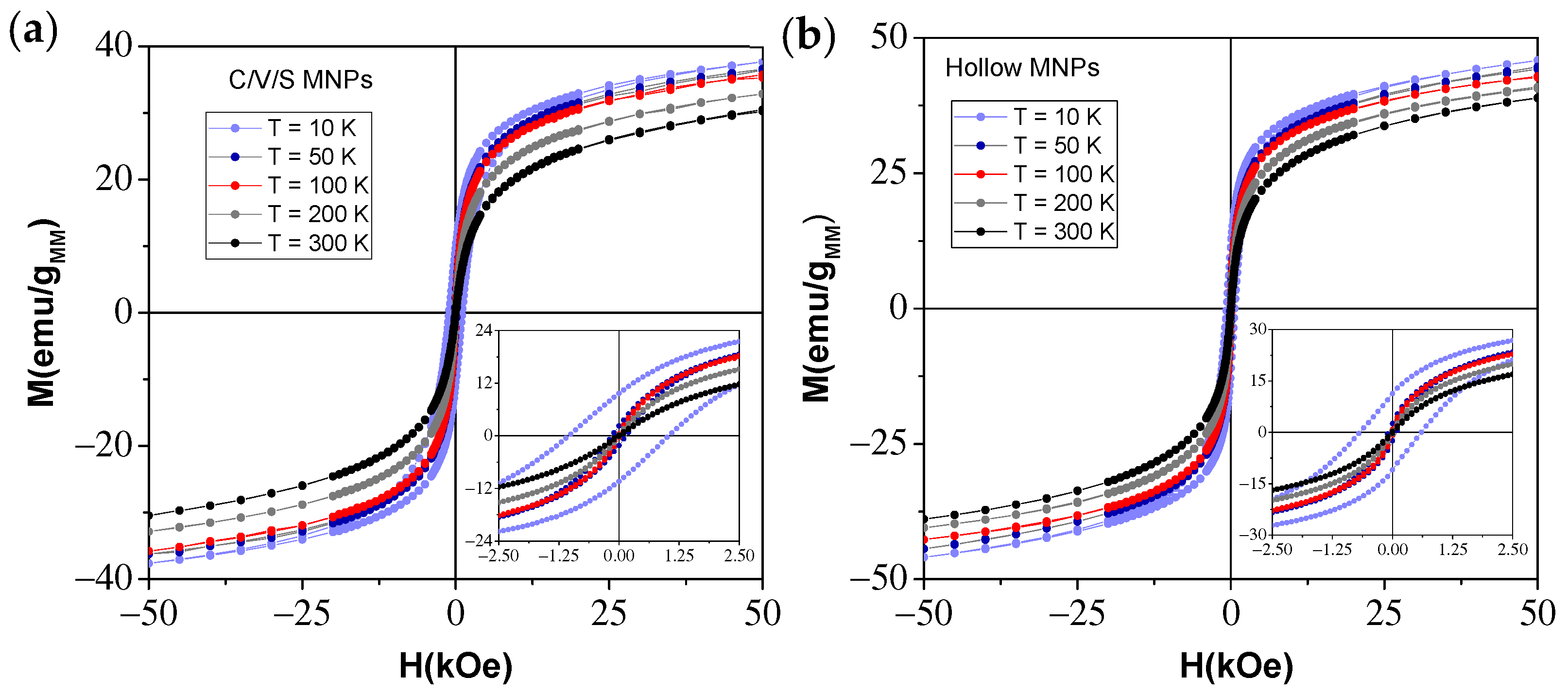

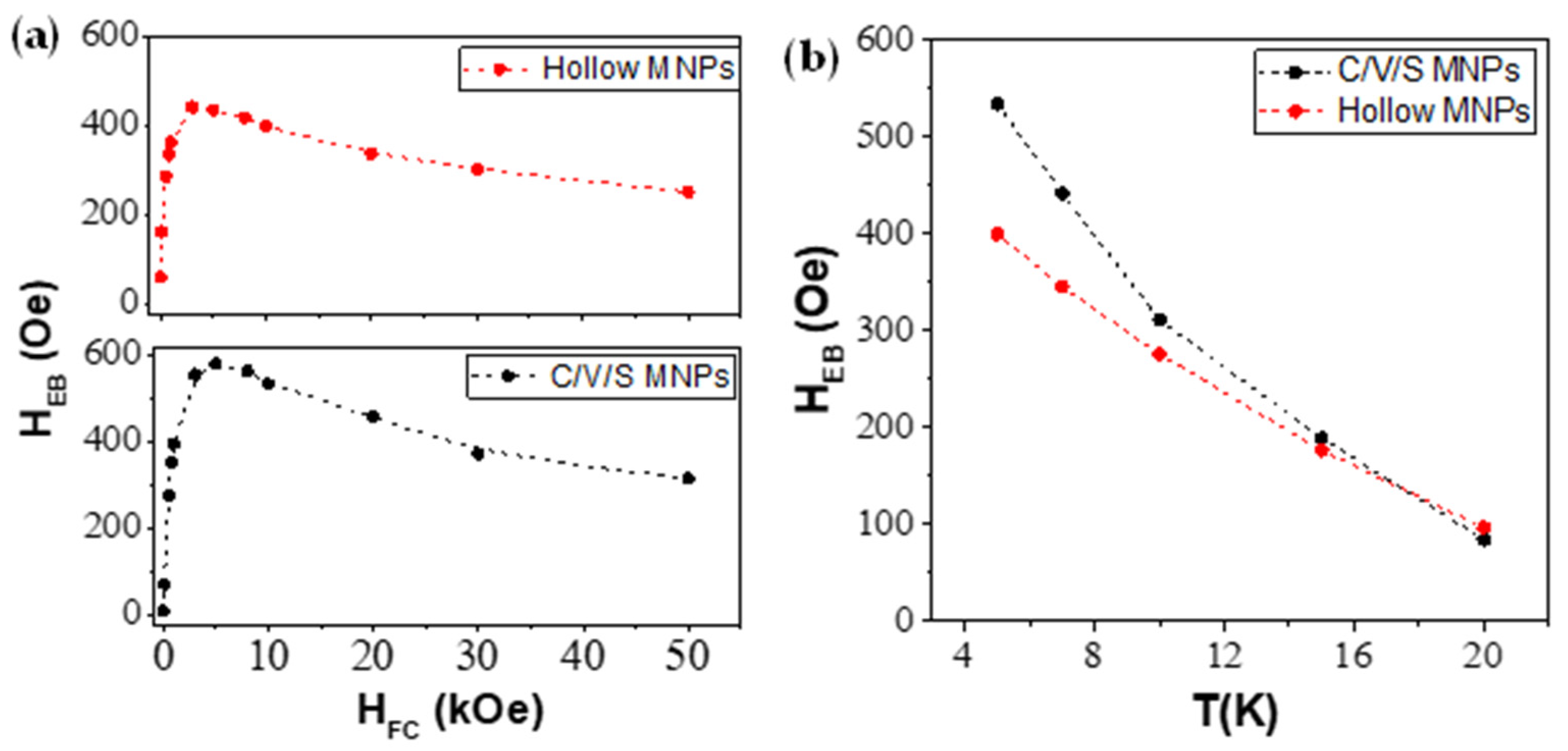
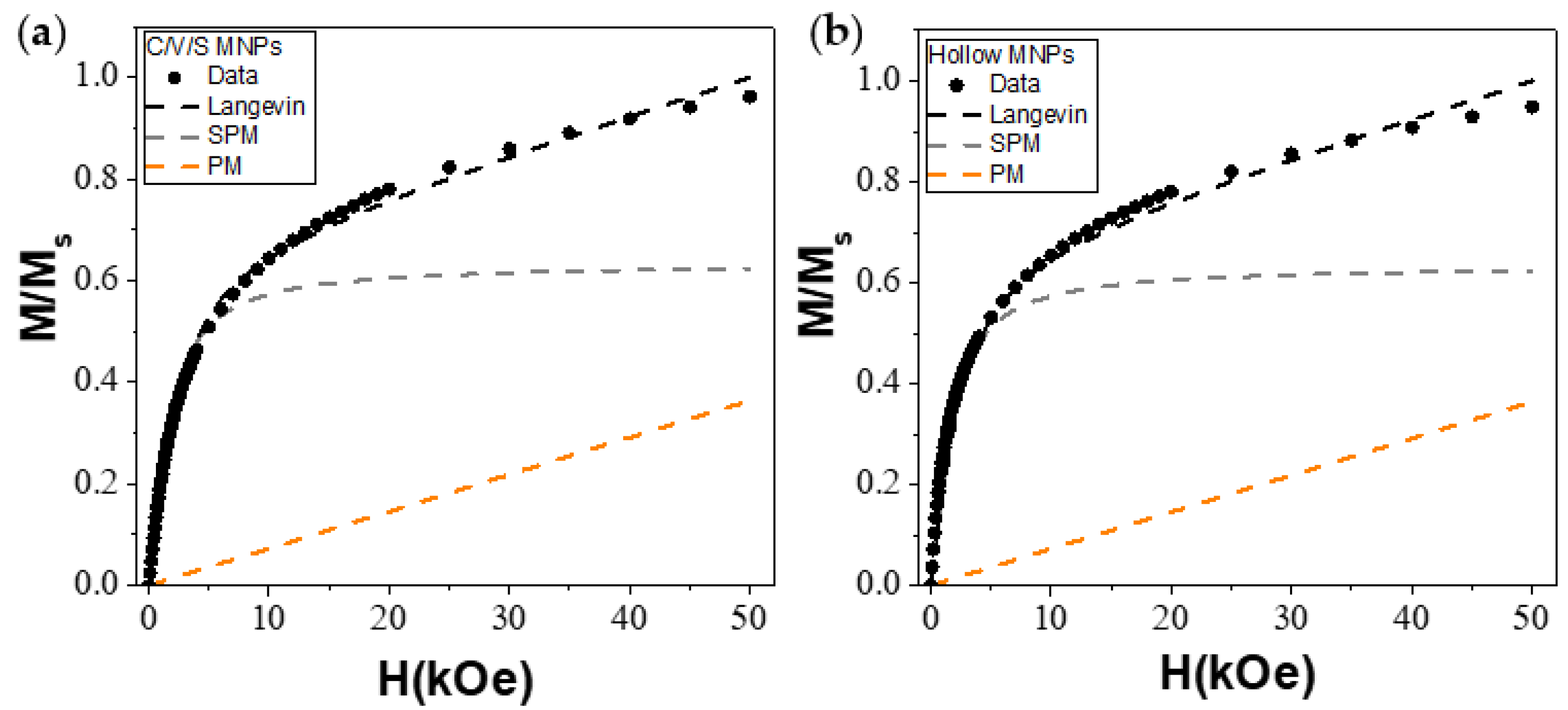
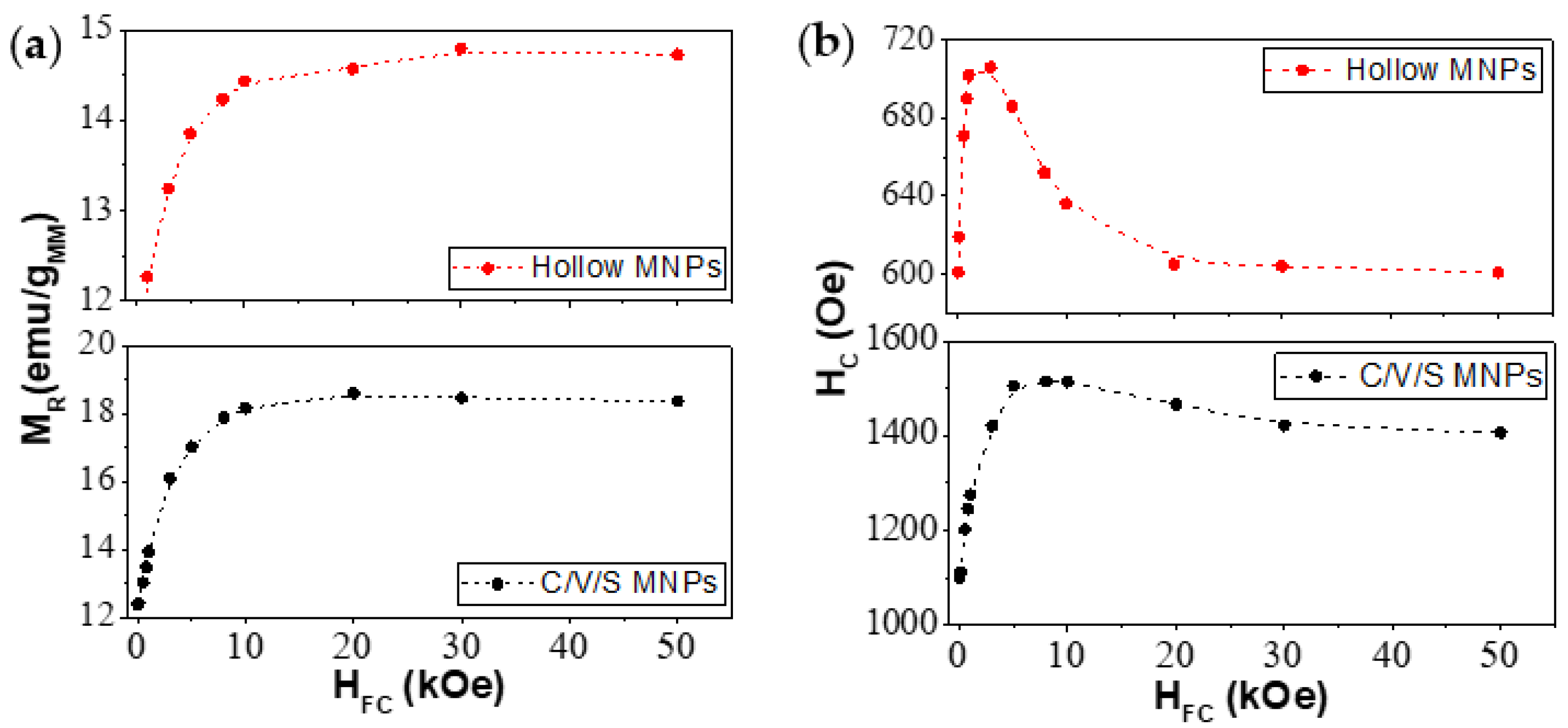
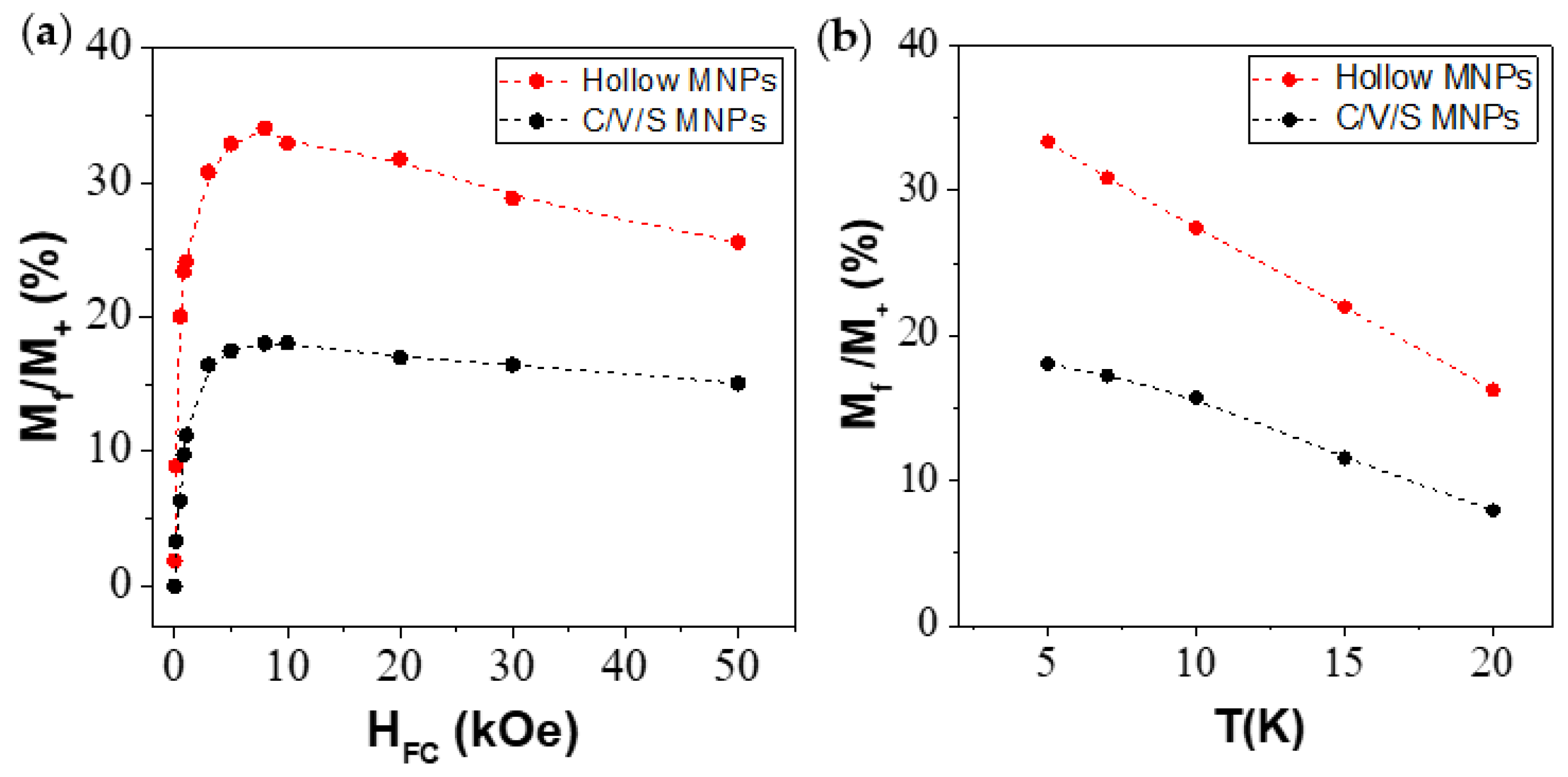
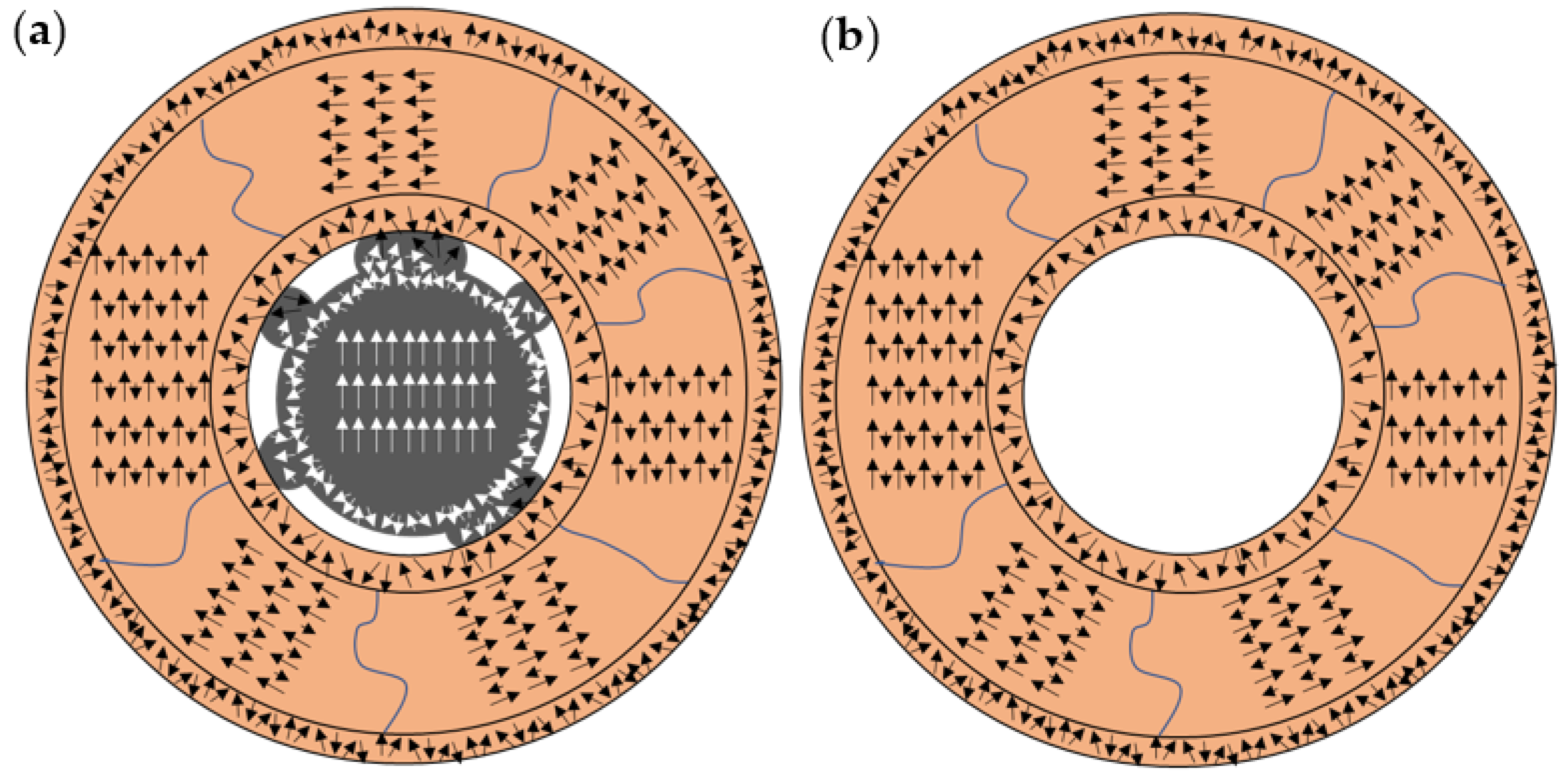
| Router (nm) | Rinner (nm) | RCore (nm) | δshell (nm) | δvoid (nm) | S/V | |
|---|---|---|---|---|---|---|
| Hollow | 6.6 | 2.9 | - | 3.7 | 5.8 | 0.6 |
| Core/void/shell | 6.0 | 3.6 | 2.3 | 2.4 | 1.3 | 0.9 |
| Core/Shell | Void? | dT (nm) | δS (nm) | HEB (Oe) | S/V | Ref |
|---|---|---|---|---|---|---|
| FeO/Fe3O4 | No | 10.1 | 0.6 | 1700 | 0.60 | [26] |
| FeO/Fe3O4 | No | 14 | 3.5 | 471 | 0.43 | [31] |
| FeO/Fe3O4 | No | 18 | ~6 | ~1000 | 0.33 | [46] |
| FeO/Fe3O4 | No | 35 | 4 | 2260 | 0.17 | [30] |
| Fe/Fe3O4 | No | 13.8 | 2.5 | 1190 | 0.43 | [23] |
| C/V/S MNPs | Yes | 11.9 | 2.4 | 581.5 | 0.9 | Present Study |
| Hollow | dT (nm) | δS (nm) | HEB (Oe) | Type | S/V | Ref |
|---|---|---|---|---|---|---|
| γ-Fe2O3 | 8.1 | 1.6 | ~3000 | Minor Loop | 1.29 | [37] |
| γ-Fe2O3 | 9.2 | 2 | - | Minor Loop | 1.05 | [34] |
| γ-Fe2O3 | 9.4 | 1.9 | ~5000 | Minor Loop | 1.10 | [32] |
| γ-Fe2O3 | 14.7 | 3.2 | ~7000 | Minor Loop | 0.66 | [32] |
| γ-Fe2O3 | 18.7 | 4.5 | 960 | EB | 0.47 | [34] |
| Fe3O4 | 16.0 | 4.5 | 133 | EB | 0.49 | [23] |
| Iron Oxide | 13.2 | 3.7 | 444 | EB | 0.6 | Present Study |
Publisher’s Note: MDPI stays neutral with regard to jurisdictional claims in published maps and institutional affiliations. |
© 2022 by the authors. Licensee MDPI, Basel, Switzerland. This article is an open access article distributed under the terms and conditions of the Creative Commons Attribution (CC BY) license (https://creativecommons.org/licenses/by/4.0/).
Share and Cite
García Acevedo, P.; González Gómez, M.A.; Arnosa Prieto, Á.; Garitaonandia, J.S.; Piñeiro, Y.; Rivas, J. Significant Surface Spin Effects and Exchange Bias in Iron Oxide-Based Hollow Magnetic Nanoparticles. Nanomaterials 2022, 12, 456. https://doi.org/10.3390/nano12030456
García Acevedo P, González Gómez MA, Arnosa Prieto Á, Garitaonandia JS, Piñeiro Y, Rivas J. Significant Surface Spin Effects and Exchange Bias in Iron Oxide-Based Hollow Magnetic Nanoparticles. Nanomaterials. 2022; 12(3):456. https://doi.org/10.3390/nano12030456
Chicago/Turabian StyleGarcía Acevedo, Pelayo, Manuel A. González Gómez, Ángela Arnosa Prieto, Jose S. Garitaonandia, Yolanda Piñeiro, and José Rivas. 2022. "Significant Surface Spin Effects and Exchange Bias in Iron Oxide-Based Hollow Magnetic Nanoparticles" Nanomaterials 12, no. 3: 456. https://doi.org/10.3390/nano12030456
APA StyleGarcía Acevedo, P., González Gómez, M. A., Arnosa Prieto, Á., Garitaonandia, J. S., Piñeiro, Y., & Rivas, J. (2022). Significant Surface Spin Effects and Exchange Bias in Iron Oxide-Based Hollow Magnetic Nanoparticles. Nanomaterials, 12(3), 456. https://doi.org/10.3390/nano12030456






